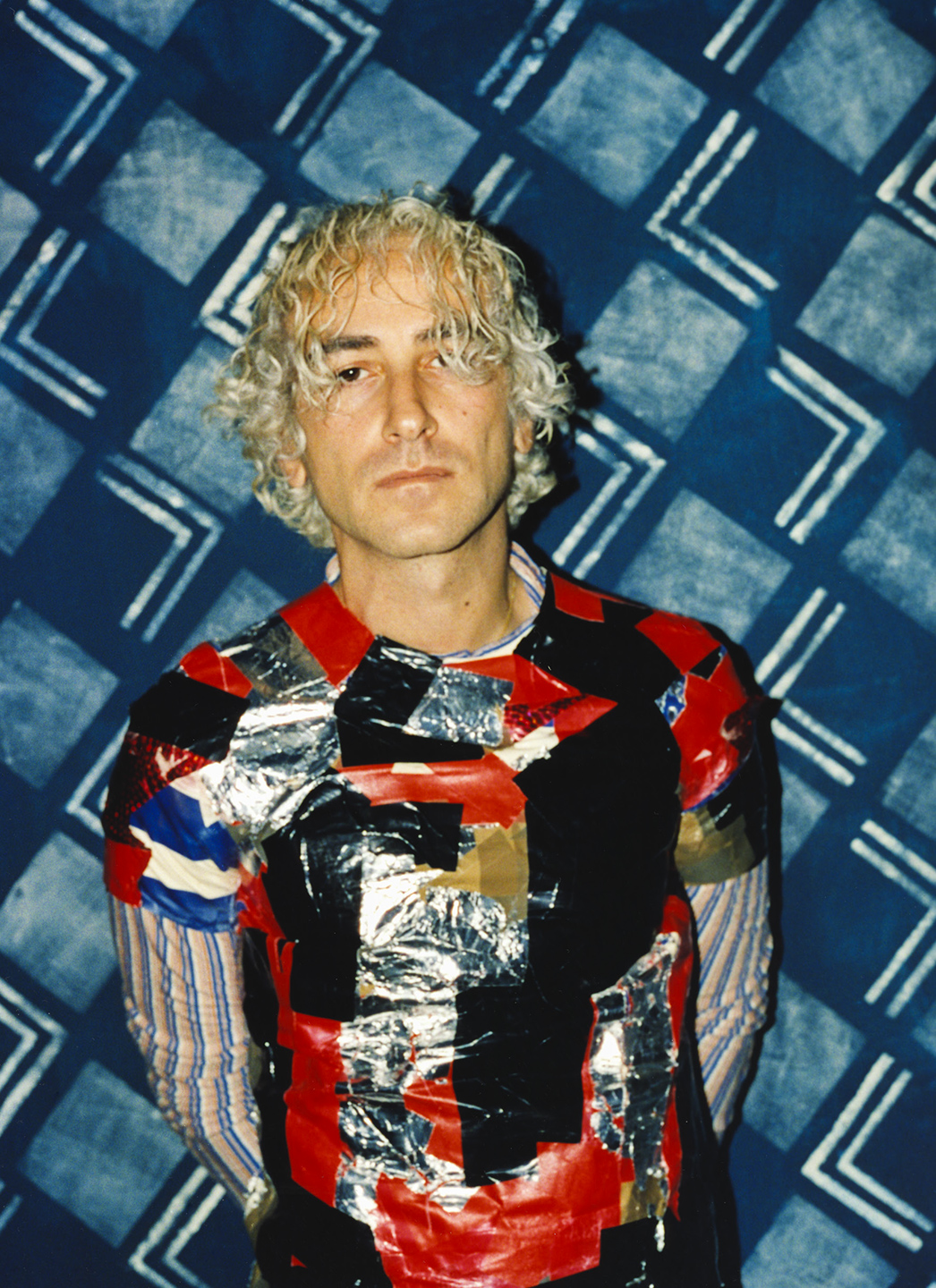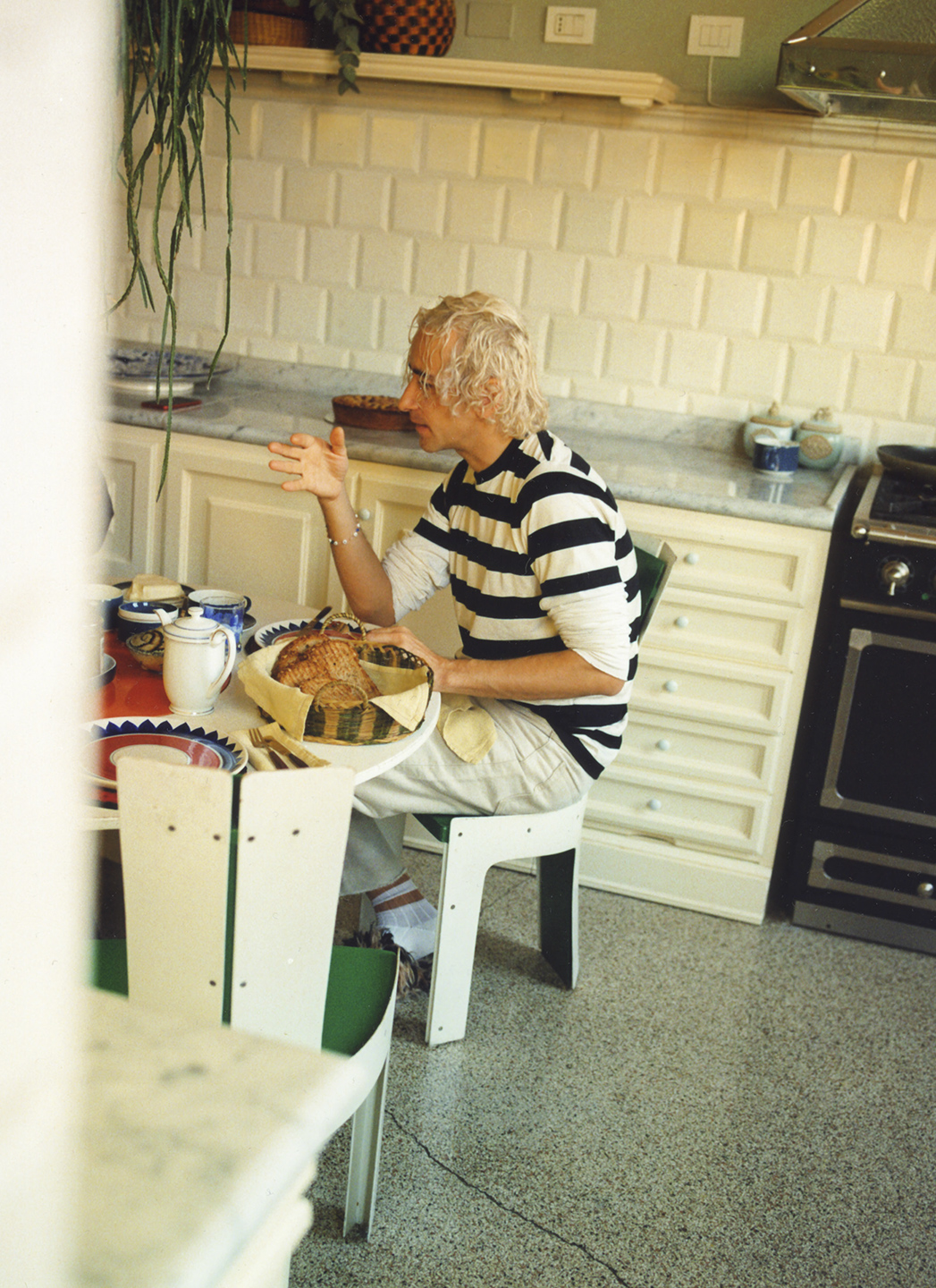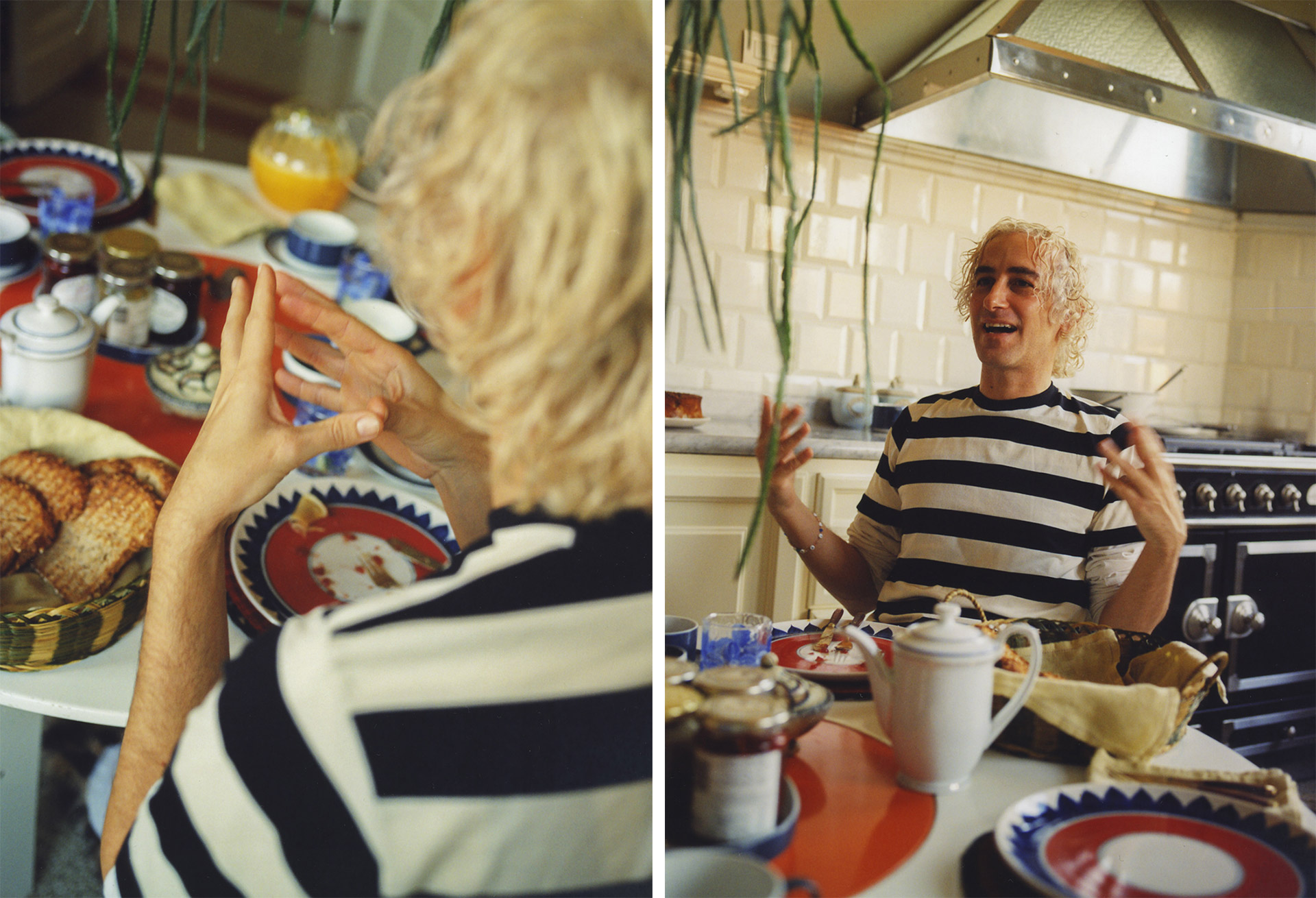Breakfast with designer Francesco Risso
at his home in Milan
Conversation with Francesca Cisani Photography Iris Humm

-
He invites me into his kitchen for breakfast on the morning of Halloween. The house suits him. It is a tangle of rooms, with decorations on every surface. Some of the walls feature boiserie hand painted by him and a designer friend from Genoa in far from orthodox colours. Curtains are made in a fabric similar to a painter’s canvas and served as an outlet for his extrovert creativity in those endless days last spring when everything ground to a halt. In the anteroom, an incredible men’s coat in shaggy English fabric, is hanging quite naturally next to a large stiff waterproof in shiny leather, adorned with splashes of paint in a floral motif. The atmosphere is classic and sophisticated in its own way. A bundle of intriguing contradictions, just like my host.
-
FCEverything takes twice as long nowadays, and we are all just trying to maintain as much normality as possible in our everyday lives.
-
FRWork has become more complicated. Although now, with another lockdown around the corner, my team have got organised: they’ve digitalised everything. During the first lockdown, in a moment of madness, I drove my Jeep to the office one morning and just grabbed everything: clothes, stands, boxes... I filled my car to bursting and I was sure I’d be stopped by the police, but I made it across town and emptied the entire studio out into one room.
-
FCWork is always a physical act for you.
-
FRVery much so. It’s very sensorial. That’s why it’s much harder now. If our offices have to close again, I’d like to create a home community so that we can continue to create with our hands. My team and I are not what you’d call photoshop savvy people.
-
FCYou place value on the physical object and the transformation of things. You destroy clothes and then put them back together.
-
FRIt is an instinctive process. At one point when I was growing up, my family home felt a bit like a commune. We all lived together: my parents, my brothers and sisters and their friends (all older than me), my grandparents. It was a clash of people. I was the quiet one, I used to raid everyone’s wardrobes. I would take their clothes, dismember them and put them back together. Jackets with no sleeves, trousers with one leg chopped off, and the inevitable family rows that followed. I couldn’t help myself: I spoke very little and that was how I expressed myself. I still do it today, my boyfriend Lawrence finds dismembered pieces of clothing whenever he goes into my archive. I can’t keep things as they are, I have to change them. I’ve never managed to buy a coat and leave it as it is.
-
FCYou make clothes that have a reason to exist, emphasising the idea of dressing up for an occasion and the pleasure of wearing those dressy outfits.
-
FRWhen you operate at a very cerebral level and concentrate on researching ideas, reality can sometimes drift away, and you enter the realm of objects that aren’t necessarily useful or suited to every occasion. Sometimes when working on the runway shows, I’ve even become caught up in displays that feel more like performance. Balance is a constant challenge. Sometimes you just let yourself go and cultivate your wildest dreams, letting the wildest clothes emerge. That’s what happened with the collection we presented in February. It is the story of a romantic process. It speaks of the importance of slowing down time, of appreciating leftovers, of wearing an old suit that you’ve spruced up: the garment becomes the spokesperson for a more distant dream.
-
FCAnd what if I asked you about blankets, for example?
-
FRBlankets are something I go crazy for. It’s silly. My mum is staying with me at the moment and the blankets are all kept in a wardrobe in her room. Just yesterday I rushed in saying, “Mum, please get all the blankets out because I need to see them!” They take me somewhere.
-
FCI’ve even seen you wearing a blanket.
-
FRYes, that’s true, occasionally I go out wearing a blanket.
-
FCI think that’s wonderful because it’s like taking a piece of home with you.
-
FRI like that interpretation.
-
FCIs it a conscious process?
-
FRIt’s a quest for intimacy. Blankets are objects that conjure up human warmth, which is increasingly rare nowadays. I have a fetish for houses and bedrooms. I am particularly fascinated by teenage bedrooms: there’s a whole world in there, which holds all the secrets of that individual and their family. The room is a portal into a home, and I wanted that idea at the centre of the Resort collection, which was presented and sold virtually. During that period of stasis, I wanted to get back in touch with the friends and models who represent Marni, the people who bring life to our collections when they wear them. We sent them the clothes and photographer Jack Davison took portraits of them over Zoom. We spied into their intimate space and it was really fun seeing Marni clothes in the private sphere. The whole project and all the interactions were really charged with positive energy and vitality, which did us a world of good after three months of isolation. That’s how Marnifesto came about, an aesthetic manifesto developed to present the summer collection.
We all lived together: my parents, my brothers and sisters and their friends (all older than me), my grandparents. It was a clash of people. I was the quiet one, I used to raid everyone’s wardrobes.

-
FCWith Marnifesto, the intimacy of those rooms is brought out into the street.
-
FRExactly. Marnifesto was based around the realities of the individuals that took part in the project: they emerge from their homes and spill out into the street, which is the common factor and symbol that unites everybody in all cities everywhere.
-
FCThe images are all set in the street in different places. Upon first glance, the differences aren’t that immediate because the perspective and the overall feel are so similar.
-
FRThat was the challenge, and perhaps a dream we all share: to break down the barriers that have defined and define this period. We are extremely divided and pent up in terms of politics, health and race. It is interesting to transform Marni into a metaphysical place where everybody comes together. Even though it’s a place that doesn’t exist. A bit like Mount Analogue.
-
FCDo you mean Mount Analogue in the novel of the same name by René Daumal?
-
FRYes, I read it this summer.
-
FCMe too! It’s an amazing book.
-
FRIt was a very interesting source of inspiration for me. It is very similar to the idea behind Marnifesto. I discovered the book through a quite brilliant documentary called Spaceship Earth, which talks about a 1991 experiment where eight visionaries are isolated within a dome that simulates the terrestrial ecosystem, Biosphere 2, to show the possibility of life beyond Earth, Biosphere 1. It all begins with the construction of a ship – just like in Mount Analogue – with which they travel the world, putting on theatrical performances.
-
FCWhich places or cities best represent you? I associate you with Genoa and Milan.
-
FRGenoa very much so, even though I initially rejected it and moved away. I distanced myself from it for a long time only to then move back there for various different stretches. Genoa, in a certain sense, is the antichrist of Milan, both in terms of the city itself and the life you lead there. It feels like a village, but it can also be extremely underground. It had a very unique nightlife back then...
-
FCGenoa is beautiful, it’s got something perverse about it.
-
FRVery much so. The Genoese are extremely proud, they tend not to reveal anything about themselves. There are some incredible secrets there: families who live in amazing palazzos with hidden wealth. Rolls-Royces locked away in the garage but torn clothes and a Fiat 500 to leave the house. This conservative aspect of the city is perfectly balanced by its dark and alternative vein. There are no club clubs in Genoa. At night, you go to these social clubs where anything can happen. Nick Masaniello is one of those. I actually worked there for a while. There are still photos of me and my cousin hanging up over the bar. I served drinks at the bar and I wasn’t really any good at it, but I loved being there. Anyone and everyone would come through and the bar was a blend of fascinating and unsettling. It’s in the heart of the historic centre, open at any hour and nobody will ever ask you to leave. It’s an unreal situation: there are musicians playing in one room and intellectuals, artists and Genoese crime bosses propping up the bar in another. As a port town, Genoa has learned to be quite open and liberal. Their stiff facades do crumble sometimes to let those inner thoughts out. The Genoese are invisible, quiet, and not flamboyant in the slightest, but they are tough, persistent, and occasionally larger than life. My grandfather was famous because he’d wear a woollen sailor’s hat and a blue woollen jumper even in August.
-
FCYour description reminds me a little of your vision of sartorial formality. All the suits look perfect but...
-
FRI tear them all up!
Genoa, in a certain sense, is the antichrist of Milan, both in terms of the city itself and the life you lead there. It feels like a village, but it can also be extremely underground. It had a very unique nightlife back then…

-
FCThere is an aura of precision and austerity that lingers though, characteristics which I think are intrinsic to the city of Milan.
-
FRYou’re right. Milan and Genoa are similar in that sense, the people are proof of that. My neighbour, who owns the whole palazzo, is so Genoese in the obsession, care and perfectionism that he devotes to it. From outside, it looks like the Addams family home. Scrappy but curated. Inside, the marble is so shiny that I’m afraid to touch it in case I leave a fingerprint and risk the wrath of the concierge! He’s a one-off in the neighbourhood though, the other palazzos are all a bit more polished. But that’s not all. I was convinced that I was living in a bourgeois stronghold with all the looks and comments I’d get every time I emerged dressed to the nines. Then I discovered that his wife is this incredible Japanese woman and also began to notice all the eccentric details in the wallpaper and around the palazzo.
-
FCTell me more about your vision of the bourgeois Milanese woman.
-
FRLet me start by saying that I hated Milan when I moved here. With the typical snobbery of someone from Genoa, it seemed cold, I didn’t get it. Then I began interacting with people, which is what my life is mainly based on here. I am very intrigued by people’s characters. Over the years, I have met a wonderful variety of people, from one extreme to the next. I am passionate about heterogeneity. My boyfriend is 20 years older than me and through him I’ve met people from his context and background, happily adapting. All the different facets of the people in Milan have influenced me and the way I work. When I got to Marni, I tried to separate myself from its Milanese-ness but eventually I willingly gave into it. After all, I worked for Miuccia Prada for 10 years and she is the heir and champion of that aesthetic.
-
FCWhat’s your favourite part of the male form?
-
FRYou tell me!

-
FCI have noticed that you often uncover the forearm. Jumpers or shirts are always rolled up.
-
FRInteresting. That must be unconscious.
-
FCThe forearms are one of the sexiest parts of the male body. On women, it’s the whole arm uncovered with a woollen sleeveless top.
-
FRAbsolutely. If you’ve got nice forearms you’re won! On women, it’s the line of the neck and the shoulders.
-
FCI remember one of the first times I saw you, at Cucchi, before we knew each other. I noticed you because of the freedom with which you expressed yourself. Feeling free to be yourself is something that I treasure.
-
FRI think exploring yourself is beautiful but it’s equally beautiful to see yourself through other people’s eyes. Like the fact that you’ve noticed details that I had never picked up on. I’ll be thinking about the forearm on my way back to the office now. Perhaps a whole story will start from a forearm, like in Mount Analogue.